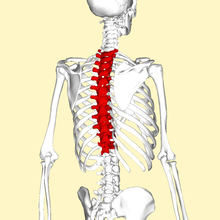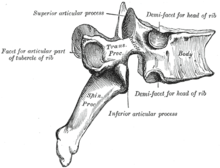Thoracic vertebrae
The thoracic vertebrae (lat. Vertebrae thoracicae) are the bony elements of the thoracic spine . These vertebrae are characterized by their contact surfaces with the ribs ( facies costalis ). The man has 12 thoracic vertebrae. They are numbered from top to bottom. They are designated according to the Latin notation with Th1 to Th12 ( Th = thoracic = belonging to the chest ).
Parts of a thoracic vertebra
- Vertebral body ( corpus vertebrae )
- 2 transverse processes ( processus transversus )
- Spinous process ( spinous process )
- 2 articular processes to the overlying vertebra ( superior articular process )
- 2 articular processes to the underlying vertebra ( inferior articular process )
- Vertebral arch ( Lamina arcus vertebrae )
- Connection between the vertebral arch and the vertebral body ( Pediculus vertebrae )
- 2 articular surfaces to the ribs ( facies costalis )
The shape and size of the individual thoracic vertebrae is different, as is the alignment of the joint surfaces and the alignment of the vertebrae in the space itself. The size of the vertebral bodies increases from cranial (head towards the head) to caudal (towards the tail).
The spinous processes ( spinous processes ) are palpable on leichtesten back. They overlap downwards like roof tiles and are therefore slightly lower than the respective vertebral body.

